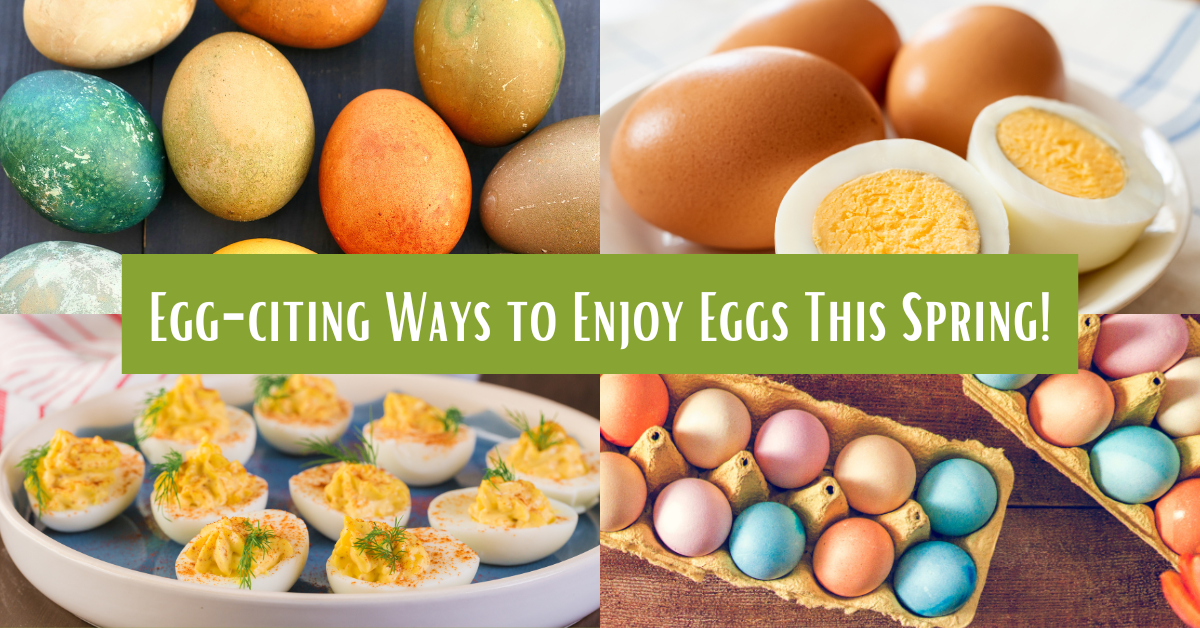
Have you tried coloring Easter eggs with natural resources around you, rather than relying on harsh, store-bought dyes? Color comes from the earth after all! Some fruits, spices, veggies, and juices can naturally color your Easter eggs. If you prefer dyeing hard-boiled eggs, these dye agents are safe to eat! Explore natural ways to dye your eggs, fun ideas to try with the kiddos, and our favorite way to enjoy hard-boiled eggs this spring.
Boiling Your Dyes
- Bring 2 cups of water to a boil.
- Add your coloring fruit, spice, or veggie.
- Reduce heat and simmer for 30 minutes or longer.
- Strain liquid into a jar and cool to room temperature.
- Stir in 2 tablespoons of white vinegar and add your hard-boiled eggs. The vinegar helps bond the color to the egg shell.
- Seal the jar and refrigerate overnight or until the egg is your desired color.
- Remove the eggs and you’re done! You can rub the eggs with a dab of vegetable oil to give them a shiny finish.
Recipe adapted from All Recipes
The items you’ll use for your dyes:
Lavender or Red (depending on seeping time)- 1 cup red onion skins
Rust- 7 yellow onion skins
Orange- 3 tablespoons chili powder
Yellow- 3 tablespoons ground turmeric or cumin
Green- 2 cups spinach
Light blue- 1 ½ cups shredded red cabbage
Purple- 1 ½ cup of shredded red beets
Liquid Dye Agents
These items will dye without boiling, but the process is similar to the one above, adding 2 tablespoons of white vinegar and 2 cups of the juices to the jar with the eggs. Grape juice produces a blue color, blueberry juice creates a darker, royal blue, pickled beet juice creates a light pink, and brewed coffee creates a brown color, shading varying on what type of coffee you use. Soak in the fridge overnight for the best results!
Get Creative with Your Eggs
Try using washi tape to create a checkered pattern or wrap the eggs with cotton twine to create fun patterns. Dye the eggs first for a short amount of time, wrap them with the tape or string, and dye them again to get a two-shaded effect.
To create a tie-dye pattern on your eggs, wrap them in a paper towel and drop food coloring directly on the paper towel over the egg, using different colors like you would tie-dye a shirt. Spray the paper towel with a mixture of 1 cup of water and 1 teaspoon of vinegar. Allow the eggs to sit for a minute to soak the dye and consider removing them from the paper towel with gloves to not dye your hands. The result is a beautiful, marbled egg!
For the kiddos to let their imagination run wild, use basic craft supplies like pipe cleaners, googly eyes, markers, and stickers. Create little monsters, farm animals, or people- whatever your kiddo’s imagination desires.
For an easy and simple decorating effect, use a white crayon to draw designs on your eggs before dyeing! The dye won’t stick to the wax, so your white creations will shine after the dyeing process.
Hard Boiled Eggs are an Egg-celent springtime treat!
Eggs are popularly centered around the Easter holiday, not just for decorating but eating too. This tradition stems from the medieval period where eating eggs during Lent was forbidden, so when Easter Sunday came, eggs were a treat for everybody! Hard-boiled eggs are enjoyed in many ways during the spring. We’re a sucker for a classic deviled egg appetizer, egg salad sandwich, or just a classic hard-boiled egg with toast and jam.
Try this yummy-looking recipe for deviled eggs for your Easter brunch, or give your creativity a try with these cute deviled eggs chicks!
We love springtime and the Easter holiday for the celebration of rebirth and regrowth, with new babies gracing our farm and flowers peeking through the melting snow. We have an abundance of eggs to suit your springtime needs! Get your medium, large, extra-large, and jumbo size eggs in our online store.
